|
Page < 1 2 3 4 5 6 7 8 9 10 11 12 13 14 15 16 17 >
A Glorious Hindu Legacy: Indic influence in Southeast
Asia.
Hinduism in Burma
(Myanmar)
Burma was known as Indra-Dvipa. Hindu settlements began to be established
in Burma before the first century A.D.
Horace
Hayman Wilson
who used to be professor of Sanskrit
at Oxford University, says:
"The civilizations of the
Burmese and the Tibetans is derived from India."
(source: Hindu
Superiority - By Har Bilas Sarda p. 180).
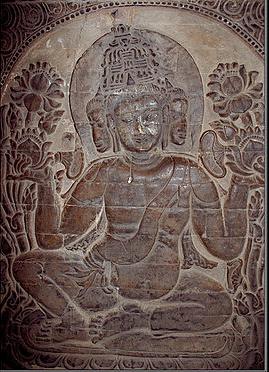 It is contended that this relationship can be
traced back to the time of the Buddha. Hindu settlements were set up in Arakan,
Tagaung, Srikshetra, Thaton and Pegu at a very early period. Literary and
archaeological evidence shows that the entire culture and civilization of Burma
was borrowed from India and not from China. Ptolemy, the geographer, tells us
that in the 2nd century A.D. many places in Burma had Sanskrit names. Indian
religions flourished in Burma. Many religious structures having the images of
Indian gods and goddesses have also been found from Burma. It is contended that this relationship can be
traced back to the time of the Buddha. Hindu settlements were set up in Arakan,
Tagaung, Srikshetra, Thaton and Pegu at a very early period. Literary and
archaeological evidence shows that the entire culture and civilization of Burma
was borrowed from India and not from China. Ptolemy, the geographer, tells us
that in the 2nd century A.D. many places in Burma had Sanskrit names. Indian
religions flourished in Burma. Many religious structures having the images of
Indian gods and goddesses have also been found from Burma.
Burmese history
had been buried for a century or more as part of "Farther India."
The Burmese who are most Hinduised are the Mons. Some of their places have Pali
names. The Mon kingdom in the 6th century A.D. was known as Dvaravati. The
rulers of this kingdom had mostly Indian names. The Mon
settlements of the Hindus were known as Ramanna-desa.
(Note:
Considered
the national epic of Myanmar, the Yama
Zatdaw, an adaptation of Ramayana,
has been influenced greatly by Thai, Mon, and Indian versions of the play. The
Burmese name for the story itself is Yamayana,
while zatdaw refers to the acted play).
The Yama Zatdaw was introduced by oral
tradition during King
Anawratha's reign. It was influenced greatly by Ayutthaya
Kingdom, during which various Konbaung
Dynasty kings invaded the kingdom. The invasions often brought back spoils
of war, including elements of Ramakien
(Thai version of Ramayana) into the epic. The characters of Yama Zatdaw share
the same features and characteristics as those in the original story. However,
in acting, the costumes are a mixture of Bamar
and Thai
elements. The names of the characters, in general, are Burmese transliterations
of the Sanskrit names. Rama
is known as Yama; Sita
is known as Thida; Ravana
is known as Dat-thigiri).
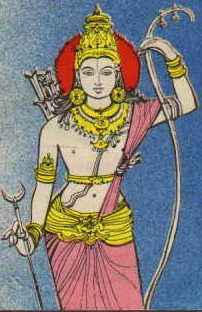 Ramayana and Mahabharata the two ancient
Sanskrit epics of India exerted a profound impact upon the cultures of South
East Asia and have played no small role in the Indianisation of the major
portion of that region. Out of ASEAN TEN at least seven nations Myanmar, Laos,
Cambodia, Thailand, Malaysia, Brunei and Indonesia have received the influence
of Hindu culture since the early days of Indian colonisation. Ramayana and Mahabharata the two ancient
Sanskrit epics of India exerted a profound impact upon the cultures of South
East Asia and have played no small role in the Indianisation of the major
portion of that region. Out of ASEAN TEN at least seven nations Myanmar, Laos,
Cambodia, Thailand, Malaysia, Brunei and Indonesia have received the influence
of Hindu culture since the early days of Indian colonisation.
(source: Ramayana
in Myanmar). Refer to Rama
or Ramchandra.
The Pali literature of Burma on law is
based on the Dharamsastras of Manu, Narada and
Yajnavalkya.
The art of Burma was
also influenced by the Indian art.
In Burma, the finest temple is the Ananda at Pagan. It occupies the center of a
spacious courtyard which is 564 ft square. There is no doubt of its derivation
from Indian type. Temples of the same type existed in Bengal and most probably
suggested the model of the Ananda temple.
Charles Duroiselle, pioneer of Burmese Studies in
France, who composed the Epigraphia Birmanica,
says on the Ananda temple:
" There can be no doubt that the architects who planned and built the
Ananda temple were Indians. Everything in this temple from Sikhara to the
basement as well as the numerous stone sculptures found in its corridors and the
terra-cotta...adoring its basement and terraces, bear the indubitable stamp of
Indian genius and craftsmanship...In this sense, we may take it, therefore, that
the Ananda, though built in the Burmese capital, is an Indian temple."
(source: Ancient
India - By R. C. Majumdar p. 497).
Michael
Symes author of An
Account of an Embassy to the Kingdom of Ava in the Year 1795 p.
326 says: "The Burmans, we are told, call their Code generally, Dharmasath
or Shastra; it is one among the many commentaries of Manu. Mr. Syme speaks in
glowing terms of the Code."
(source: Hindu
Superiority - By Har Bilas Sarda p. 180-181).

Hindu Bas-relief inside the Nan
Paya Temple, Burma.
***
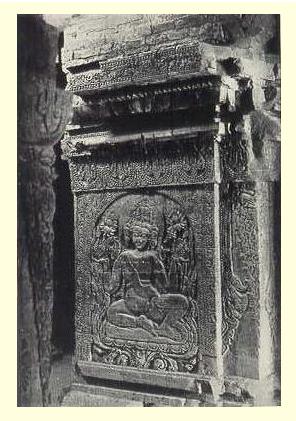
Nan Paya temple at Myinkaba,
Near Pagan, Burma.
***
The names of its rivers are Sanskrit names
- Irrawati, Brahmaputra and Chindwin. Her head of state is also known as
Adipadi,
which is the Sanskrit Adhaipati, referring to the chief executive.
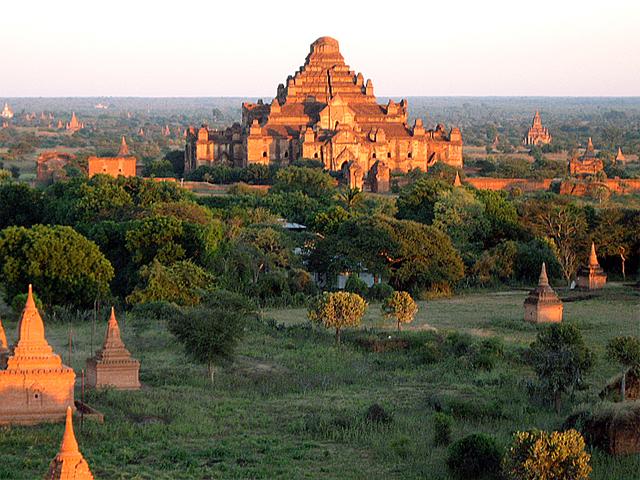
The
Pagan
Kingdom
(849-1287) is considered to be the first Burmese empire.
During the time of the Pyu kingdom, between about 500 and 950, the Bamar, people
of the Burmese ethnic group, began infiltrating from the area to the north into
the central region of
Burma
which was occupied by Pyu people that had come under the influence of Mahayana
Buddhism from Bihar and
Bengal
. By 849, the city of
Pagan
(now spelled Bagan had emerged as the capital of a
powerful kingdom that would unify Burma
and filled the void left by the Pyu.
(image
source: Pagan
Kingdom).
***
Indian-Hindu influences must
certainly have been the strongest if not the earliest influence upon that
countryside. The Sarabha Gate, still
standing, is commonly associated with 9th century King
Pyinbya.
 It is the frontispiece to what will become Pagan a century
and half later. It is Hindu in design and structure. This great out reach of
Indian-Hindu style is also evident in some 9th century ruins surrounding Angkor Wat. This Hindu push through India, Burma, Thailand, Indochina and Indonesia
must have been an extraordinary one, certainly equal to the Graeco-Roman thrust
on the Mediterranean cultures. It left behind an indelible imprint upon the
civilizations of those two peninsulas of Asia stretching deep into the Indian
Ocean. The mark of its art, architecture, and its religion are still to be found
in these Buddhist and Moslem countries. It is the frontispiece to what will become Pagan a century
and half later. It is Hindu in design and structure. This great out reach of
Indian-Hindu style is also evident in some 9th century ruins surrounding Angkor Wat. This Hindu push through India, Burma, Thailand, Indochina and Indonesia
must have been an extraordinary one, certainly equal to the Graeco-Roman thrust
on the Mediterranean cultures. It left behind an indelible imprint upon the
civilizations of those two peninsulas of Asia stretching deep into the Indian
Ocean. The mark of its art, architecture, and its religion are still to be found
in these Buddhist and Moslem countries.
***
A paltry 2
per cent of the Burmese population amounting to 240,000 accounts for Hindus that
too happen to be Burmese Indians. But Hinduism held a major sway over Burmese
history and thereupon its literature.
Yama
Zatdaw is Burmese rendition of the Ramayana.
The dominant ethnic group, Bamar living mostly in countryside follow Nat worship
which has several adaptations of Hindu Gods and Goddesses. The Burmese God
Thagyamin, King of the Nats rides a three-headed elephant is identified with
Indra, the king of Hindu Gods. Burmese Buddhists are devout of Thuyathadi,
counterpart of Goddess Saraswati. As the
Goddess of knowledge, She is avidly worshipped by students before examinations.
Some other Gods are as well worshipped by Burmese Buddhists.
Burmese language as such contains plethora of
loanwords from Sanskrit and Pali, many being connected with
religion. In Burmese culture several Hindu traditions are still
perceived especially on the Burmese New Year festival, Thingyan
and also during weddings. Hinduism along with Buddhism greatly
influenced the royal courts of Burmese monarchs including their
formal royal titles. The coronation ceremonies were also Hindu
in origin. The architecture seen at places like Pagan reflect
profound Hindu influence.
(source: Hinduism
throbbing high in
South East Asia
(Part II of III) - By Ratnadeep
Banerji).
Nathlaung Kyaung:
Hindu Temple in Myyanmar
Located in the city walls of Old Bagan,
Nathlaung
Kyaung
is only surviving Hindu temple in Bagan. Dedicated to the Hindu god
Lord Vishnu, the square brick temple was
built in the 10th or 11th century, making it one of the earliest temples at
Bagan.


Dedicated to the Lord Vishnu, the square
brick temple was built in the 10th or 11th century, making it one of the
earliest temples at Bagan.
***
The Nathlaung Kyaung (or Nat-hlaung-kyaung), located slightly to the west of
Thatbyinnyu and inside the old city walls, is the only remaining Hindu temple in
Bagan. It was possibly built by legendary King Taungthugyi (r. 931-964) about a
century before King Anawrahta (r. 1044-1077) brought Theravada Buddhism to Pagan
with the conquest of Thaton.
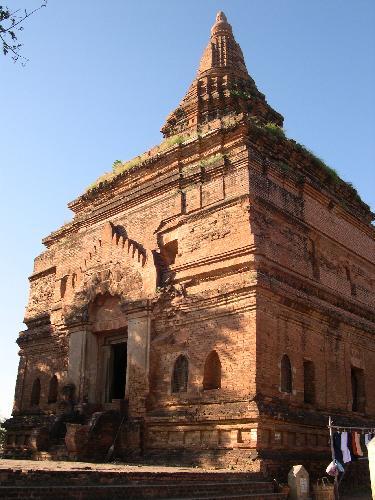 Whenever
it was built, the fact that it was not destroyed indicates a tolerance of
Hinduism in Buddhist Bagan. Nathlaung was dedicated to the Hindu god Vishnu and
served as the temple of the Indian merchant community at Bagan and brahmins in
the service of the king. It may have been built by Indian artisans. Whenever
it was built, the fact that it was not destroyed indicates a tolerance of
Hinduism in Buddhist Bagan. Nathlaung was dedicated to the Hindu god Vishnu and
served as the temple of the Indian merchant community at Bagan and brahmins in
the service of the king. It may have been built by Indian artisans.
Only the main hall and
superstructure of Nathlaung Kyaung still stand. The square temple is made of
brick and has steep upper terraces, a dome and crumbling
gopuram/sikhara (Indian-style finial). Originally there were Gupta-style
statues of 10 incarnations of Vishnu housed in niches in the outer walls;
seven of these survive. Badly damaged brick and stucco reliefs of Vishnu can be
seen on each of the four walls.
The high mandapa (porch that extends
from the temple) was given by a Malabar Vaishnavite saint in the 13th century.
The only mandapa in Bagan, it was originally covered by a wooden awning.
In the 1890s, a German oil engineer
took the large Vishnu statue from the temple; it can now be seen in the
Dahlem Museum in Berlin. The temple was
badly damaged in the 1975 earthquake, and considerable repairs were made in
1976, especially to the second story.
(source:
Nathlaung Kyaung:
Hindu Temple in Myyanmar).
India To
Renovate Temple In Myanmar
In a major boost to its cultural and
historic ties with Myanmar, India Tuesday agreed to renovate and restore a 12th
century temple in the ancient city of Bagan in Myanmar's Mandalay region. Indian
External Affairs Minister S.M. Krishna made the offer to the three-month-old
Myanmarese civilian government. The Ananda Pahto, which dominates Bagan's
skyline with a 167 foot temple tower, is one of the oldest of temples in
Myanmar. Bagan is about 125 miles away from Myanmar's second largest city,
Mandalay.
Ananda Pahto, along with the mighty
mid-12th century temple Thatbyinnyu Pahto, dwarf all other modern constructions
in Bagan including the archaeological museum there.
(source:
India To Renovate Temple In Myanmar).
Top
of Page
Page < 1 2 3 4 5 6 7 8 9 10 11 12 13 14 15 16 17 >
|